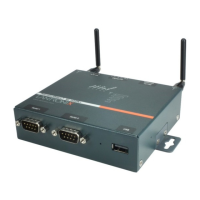
Do you have a question about the Lantronix PREMIERWAVE XC HSPA+ and is the answer not in the manual?
Highlights the main capabilities and functionalities of the PremierWave XC HSPA+ intelligent gateway.
Enumerate the network protocols and services supported by the intelligent gateway.
Describes the diagnostic tools available for troubleshooting issues with the gateway.
Outlines the different ways to configure the PremierWave XC HSPA+ intelligent gateway.
Describes the physical components of the PremierWave XC HSPA+ unit, including panels and LEDs.
Provides instructions and guidelines for securely mounting and connecting the gateway unit.
Explains how to discover the gateway on the network using the UPnP protocol.
Details the process of finding and configuring the gateway using the Lantronix DeviceInstaller utility.
Guides users on how to launch and connect to the Web Manager interface for device configuration.
Describes the initial page displayed after login, showing the gateway's current status and information.
Details the configurable settings for the Ethernet interface, including IP, DNS, and hostname.
Configures physical link parameters for the Ethernet interface, such as speed and duplex mode.
Allows configuration of Quality of Service settings to prioritize network traffic for the Ethernet interface.
Configures network failover settings for the Ethernet interface to use the cellular connection as a backup.
Details the configurable settings for the cellular interface, including APN and DNS.
Configures link settings for the cellular interface, such as APN, username, and password.
Configures Quality of Service settings for the cellular interface to manage traffic prioritization.
Configures the device to function as a gateway or router, including WAN and firewall settings.
Configures rules to forward incoming network traffic to specific internal devices or services.
Manually defines routes to be added to the device's routing table.
Configures the gateway to act as a DHCP server, assigning IP addresses to network clients.
Configures routing protocols like RIP and OSPF for network communication.
Allows mapping external IP addresses to internal LAN-side IP addresses for accessibility.
Configures Dynamic Domain Name System settings to map a dynamic IP to a hostname.
Configures Virtual Private Network connections for secure remote access and network extension.
Configures Generic Routing Encapsulation tunnels for enhanced IP tunneling capabilities.
Configures the behavior and state of the device's relay output, including latching options.
Configures the behavior and state of the device's digital input ports, including alarm triggers.
Configures the actions to be taken when specific alarms or reports are triggered, e.g., email, SMS, SNMP.
Covers the installation, uninstallation, and running of user-defined Python scripts and packages.
Configures serial line parameters such as interface type, baud rate, parity, and flow control.
Configures parameters for serial-network tunneling operations.
Sets serial interface parameters specific to tunnel configurations.
Configures how serial data is packed and sent over the network when tunnels are active.
Configures the gateway to listen for and accept incoming network connections for tunnels.
Configures the gateway to attempt outgoing network connections for tunnels, including remote host details.
Sets optional conditions for disconnecting tunnel connections, including timeouts and stop characters.
Configures modem emulation settings for compatibility with older equipment using AT commands.